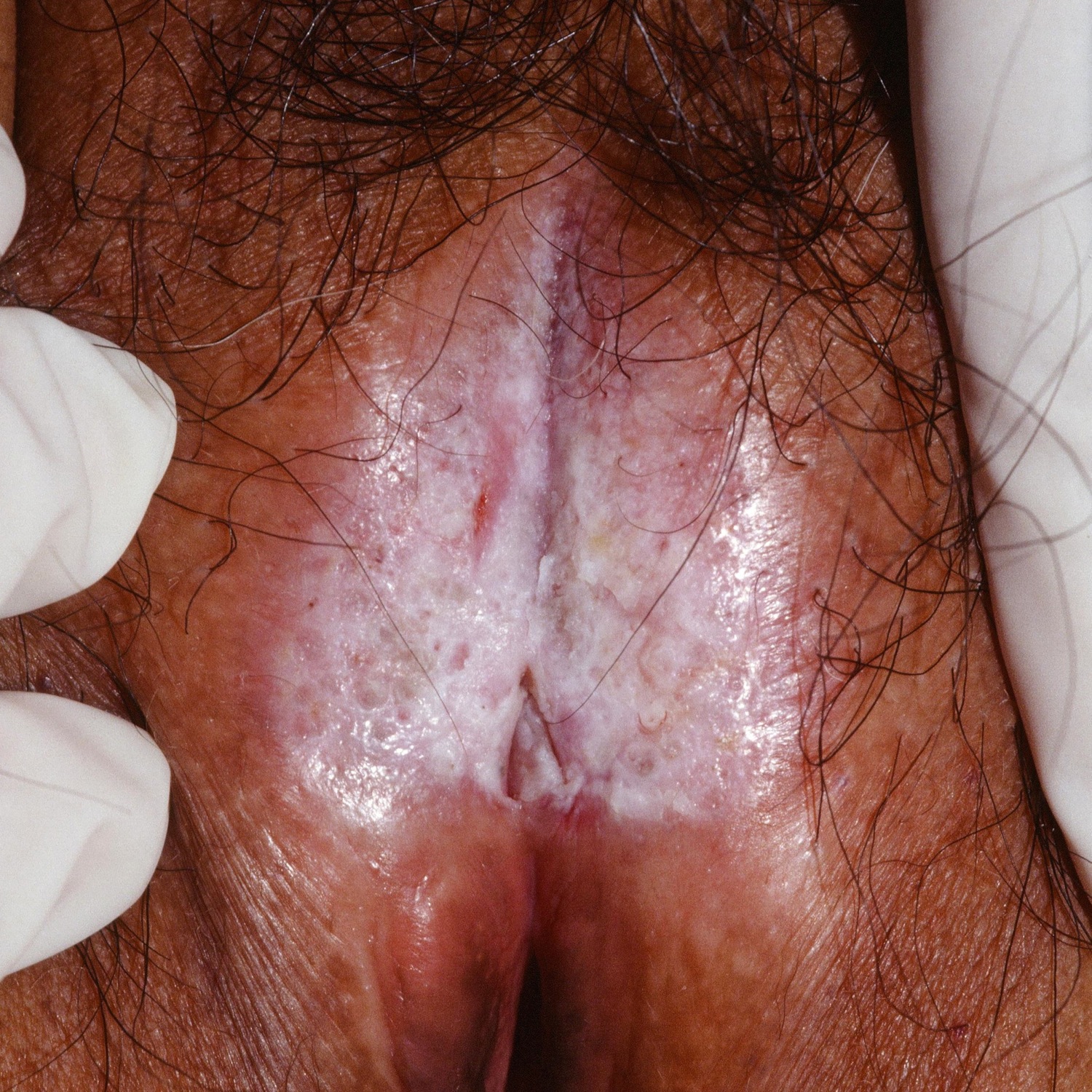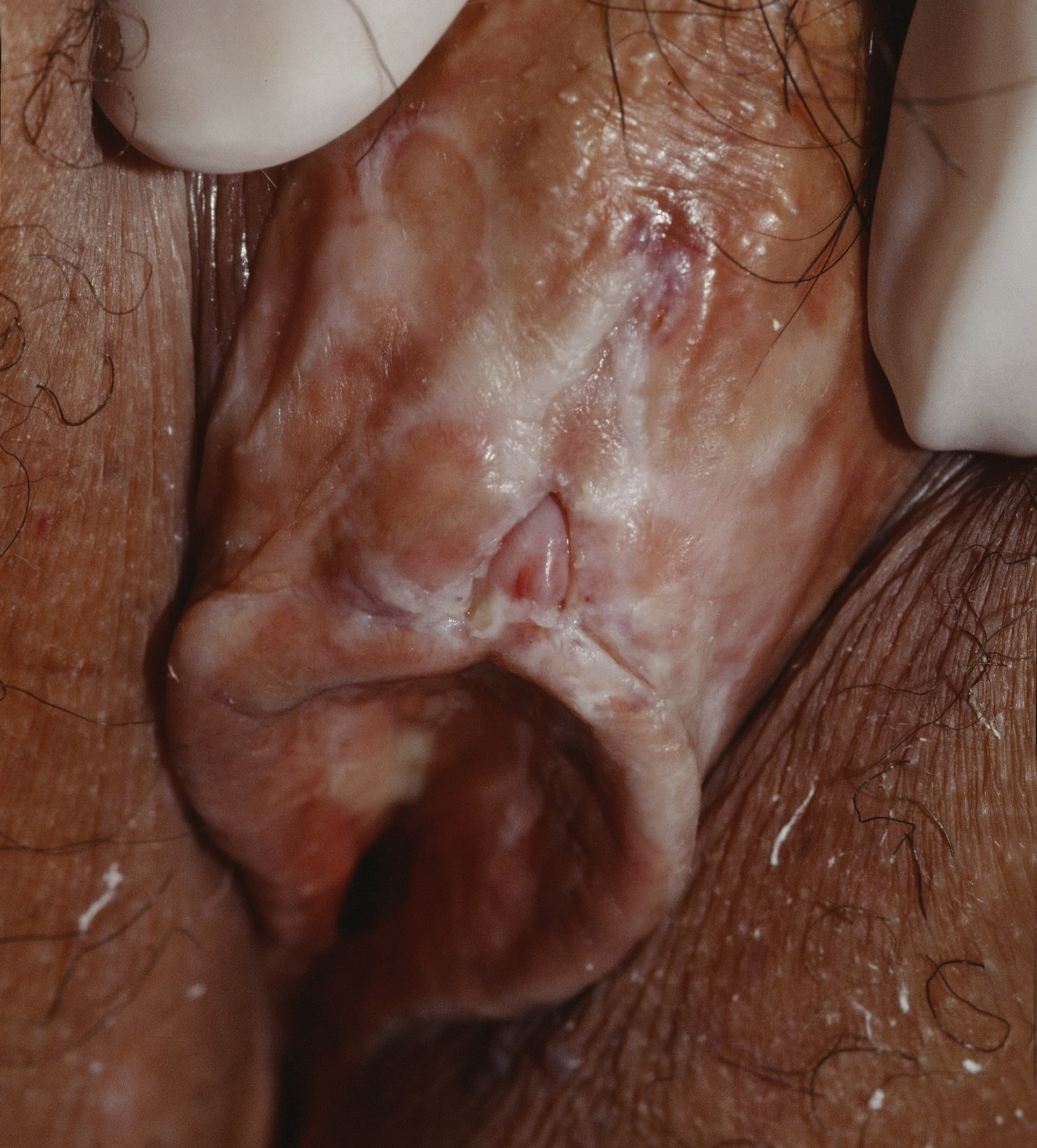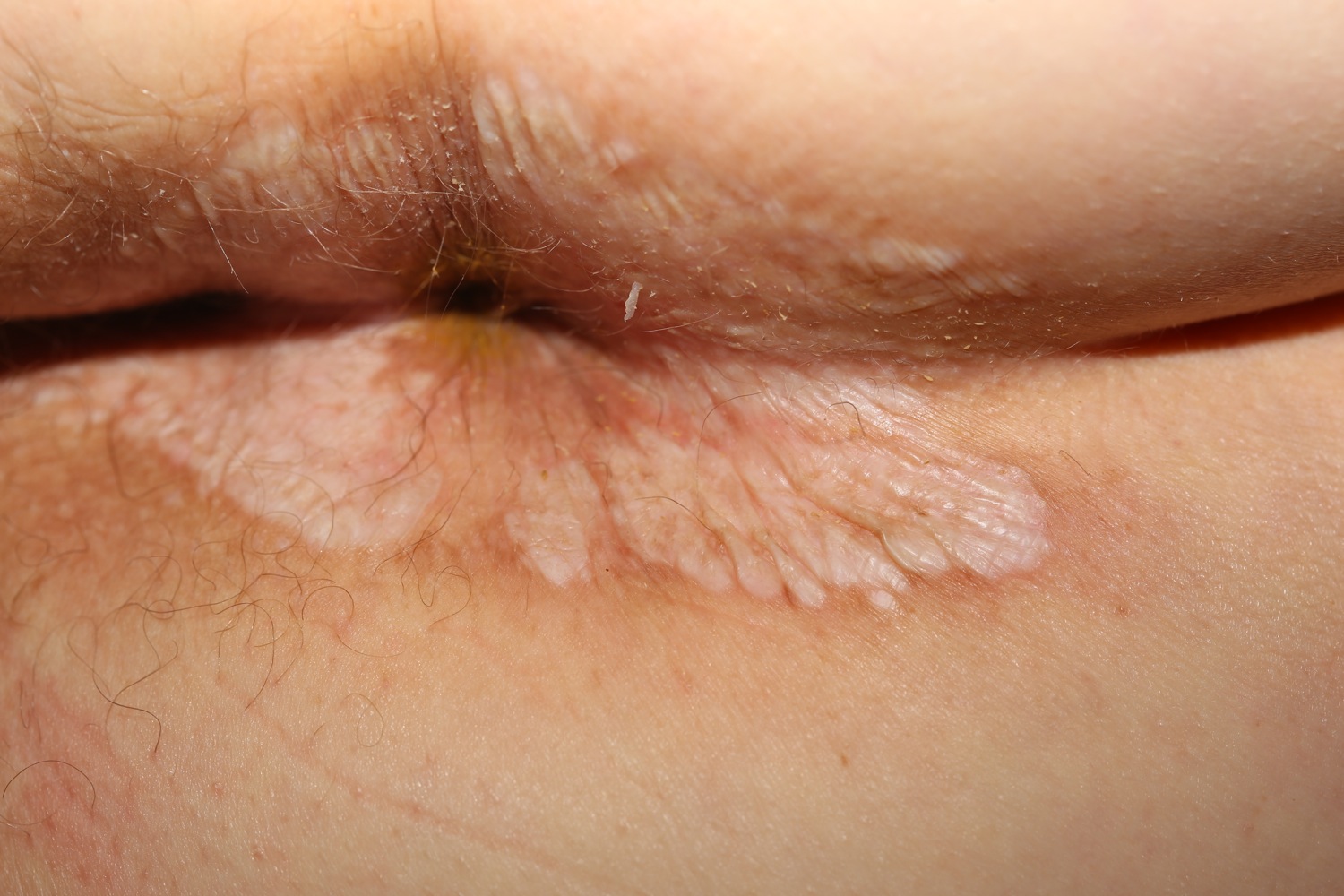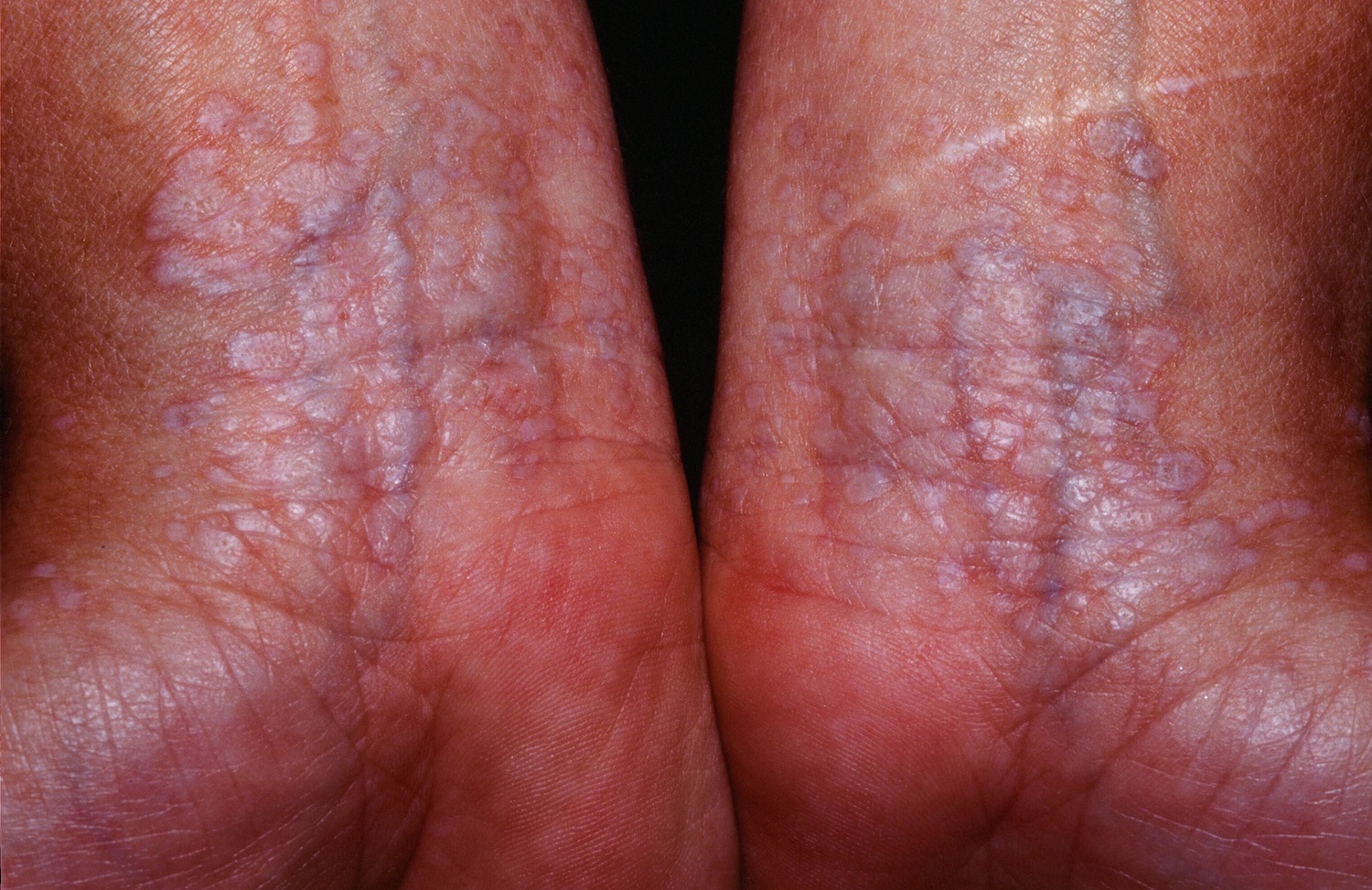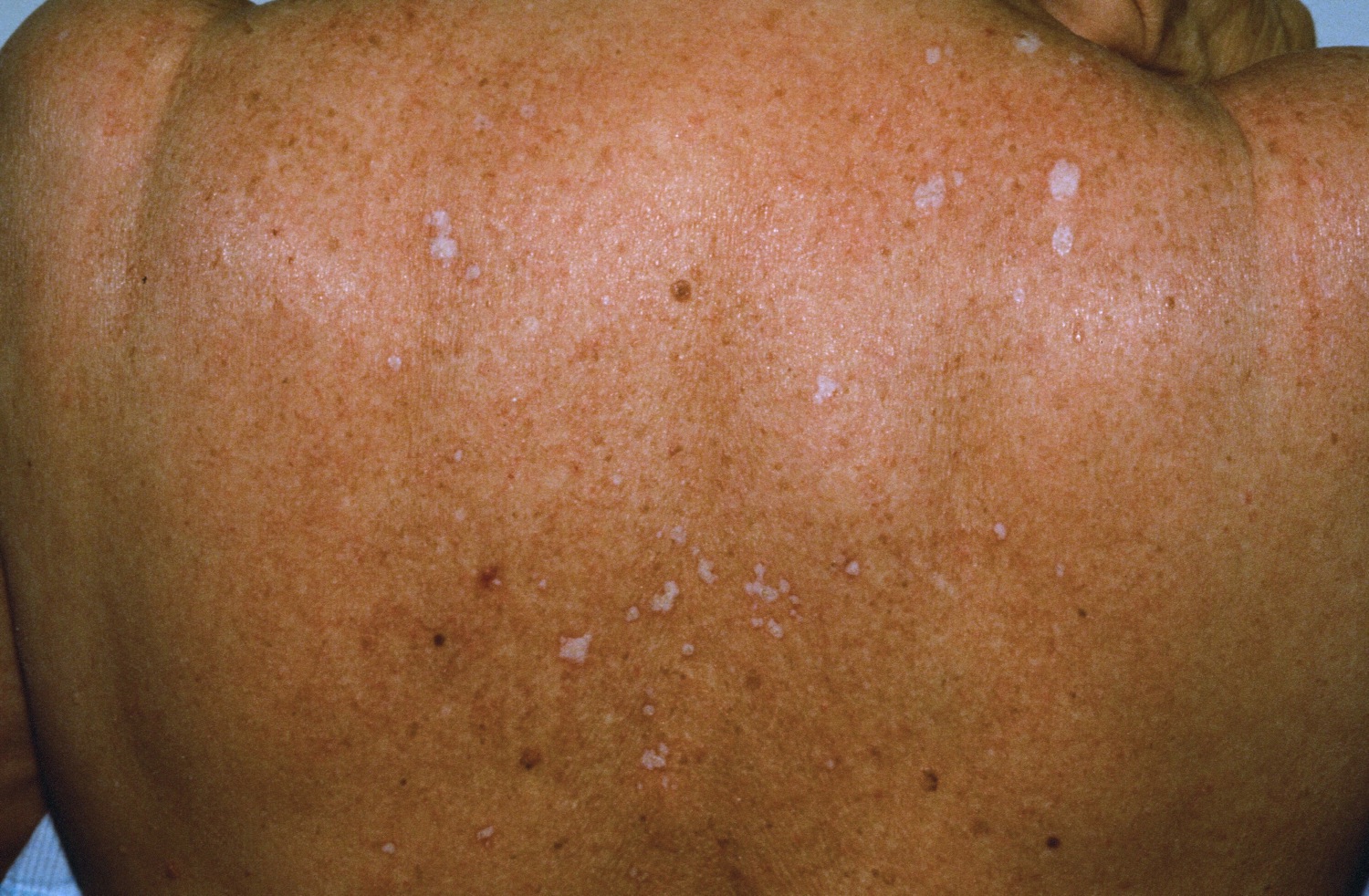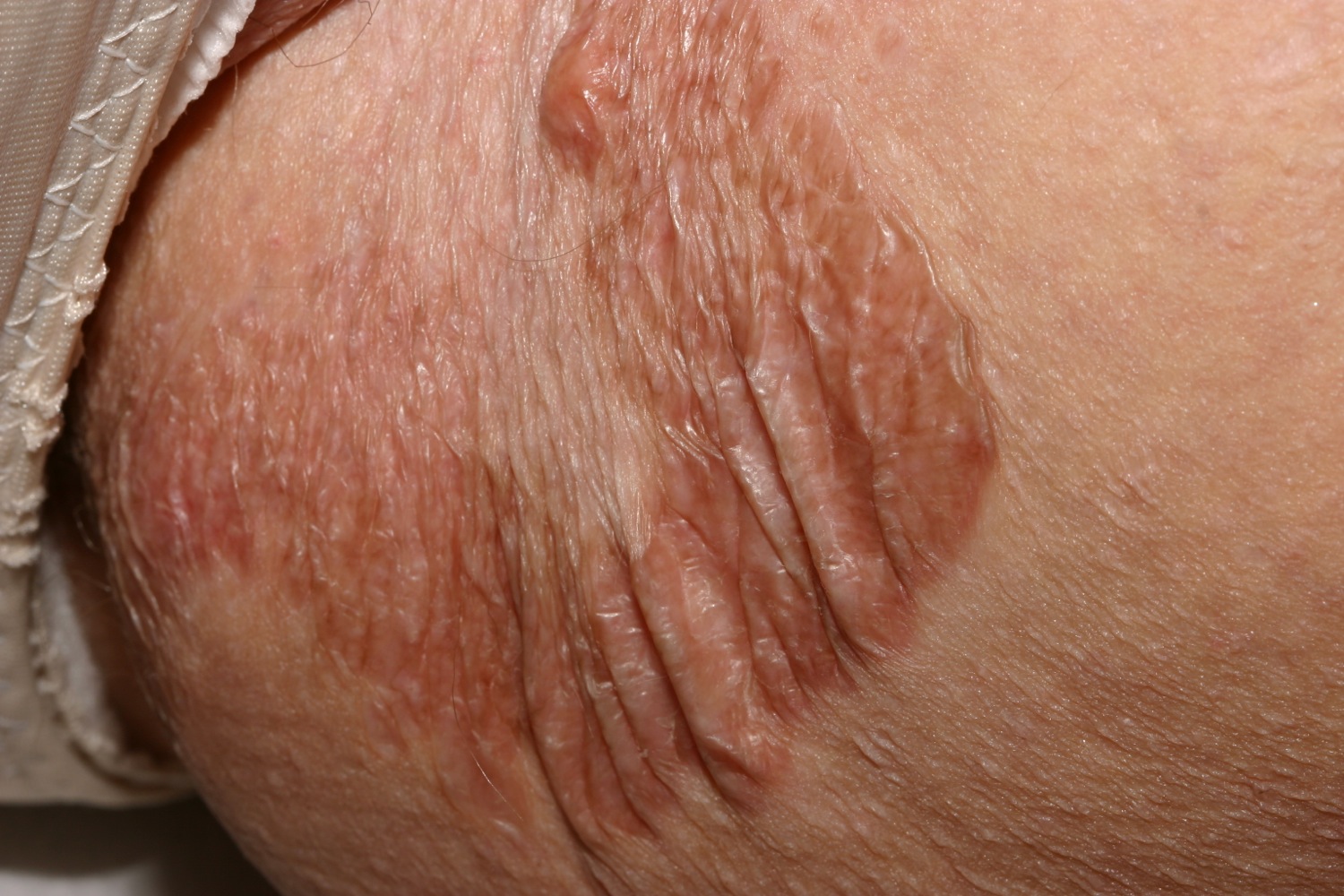What is lichen sclerosus
Lichen sclerosus is a common long-term skin disorder that most often affects genital and perianal areas. Lichen sclerosu usually causes itching and white patches to appear on the affected skin. Lichen sclerosus can also appear on the upper body, breasts, and upper arms. Lichen sclerosus is most common in women who have been through the menopause, although men and children are also sometimes affected. In women, lichen sclerosus usually involves the vulva. In boys and men, uncircumcised males are most at risk, because the condition generally affects the foreskin. In children, the signs and symptoms may improve at puberty.
Older names for lichen sclerosus include lichen sclerosus et atrophicus, kraurosis vulvae (vulvar lichen sclerosus in women) and balanitis xerotica obliterans (in males).
Intense itching often accompanies attacks of lichen sclerosus. Lichen sclerosus is not contagious nor is it a sexually transmitted disease. In the recent past, a genetic component for lichen sclerosus has been recognized. In addition, many clinical researchers believe that it is a disorder of the immunological system. The understanding of the causes of this disorder is still incomplete. Lichen sclerosus can develop concurrently with other conditions.
Lichen sclerosus does not cause skin cancer but may increase your risk for cancer if your skin is scarred. You should see your doctor every six to 12 months in order to follow and treat skin changes.
Lichen sclerosus can be uncomfortable and distressing, but sometimes lichen sclerosus improves on its own, and you won’t need any treatment – this usually only occurs when children with the condition reach puberty.
For most people, lichen sclerosus is a long-term condition that lasts many years and may flare up and down over time. There’s currently no cure, but symptoms can normally be controlled with steroid medication applied directly to the affected skin.
What does lichen sclerosus look like?
Lichen sclerosus is a skin condition that makes the vulva look white, slightly shiny, and smooth. The skin’s surface becomes thin and delicate so that it bleeds, tears, and bruises easily, often causing tiny “blood blisters”. Lichen sclerosus can also cause the skin of the inner lips of the vulva to change and shrink or get smaller. In severe cases, scar tissue can form. For example, scar tissue can cover the clitoris which can be painful.
Vulvar lichen sclerosus
Lichen sclerosus primarily involves the non-hair bearing, inner areas of the vulva.
- It can be localized to one small area or extensively involve perineum, labia minora (inner lips) and clitoral hood.
- It can spread onto the surrounding skin of the labia majora and inguinal fold and, in 50% of women, to anal and perianal skin.
- Lichen sclerosus never involves vaginal mucosa.
Lichen sclerosus can be extremely itchy and/or sore (pruritus vulvae).
- Sometimes bruises, blood blisters and ulcers appear after scratching, or from minimal friction (eg tight clothing, sitting down).
- Urine can sting and irritate.
- Sexual intercourse can be very uncomfortable and may result in painful fissuring of the posterior fourchette at the entrance to the vagina.
- It may cause discomfort or bleeding when passing bowel motions, and aggravate any tendency to constipation, particularly in children.
Lichen sclerosus causes adhesions and scarring.
- The clitoris may be buried (phimosis).
- The labia minora resorb/shrink.
- The entrance to the vagina tightens (introital stenosis).
Figure 1. Vulvar lichen sclerosus
Figure 2. Lichen sclerosus perianal area
Penile lichen sclerosus
In men, lichen sclerosus usually affects the tip of the penis (glans), which becomes white, firm and scarred.
- The urethra may narrow (meatal stenosis), resulting in a thin or crooked urinary stream.
- The foreskin may become difficult to retract (phimosis).
- Sexual function may be affected, because of painful erections or embarrassment.
Figure 3. Penile lichen sclerosus
Extragenital lichen sclerosus
Extragenital lichen sclerosus refers to lichen sclerosus at other sites.
- Extragenital lichen sclerosus affects 10% of women with vulval disease.
- Only 6% of men and women with extragenital lichen sclerosus do not have genital lichen sclerosus at the time of diagnosis.
One or more white dry plaques may be found on the inner thigh, buttocks, lower back, abdomen, under the breasts, neck, shoulders and armpits.
- Lichen sclerosus resembles cigarette paper, as the skin is dry, wrinkled and thin (atrophic).
- Hair follicles may appear prominent, containing dry plugs of keratin.
- Bruises, blisters and ulcers may appear without noticeable trauma.
Figure 4. Extragenital lichen sclerosus
Lichen sclerosus causes
The cause of lichen sclerosus is not fully understood, and may include genetic, hormonal, irritant, traumatic and infectious components.
Lichen sclerosus is often classified as an autoimmune disease. Autoimmune diseases are associated with antibodies to a specific protein.
- Extracellular matrix protein-1 (ECM-1) antibodies have been detected in 60–80% of women with vulval lichen sclerosus.
- Antibodies to other unknown proteins may account for other cases, explaining differing presentations of lichen sclerosus and response to treatment.
- However, these antibodies could be epigenetic, ie, the results of disease rather than the cause of disease.
Male genital lichen sclerosus is rare in men circumcised in infancy. It has been suggested that it may be caused by chronic, intermittent damage by urine occluded under the foreskin.
As onset in women is commonly postmenopausal, a relative lack of estrogen may be important.
Lichen sclerosus complications
Lichen sclerosus of anogenital sites is associated with an increased risk of vulval, penile or anal cancer (squamous cell carcinoma).
- Cancer is estimated to affect up to 5% of patients with vulval lichen sclerosus.
- Cancer is more likely if the inflammatory disease is uncontrolled.
- Invasive squamous cell carcinoma presents as an enlarging lump, or a sore that fails to heal.
- High-grade squamous intraepithelial lesions in females or in males associated with lichen sclerosus may be HPV-associated (usual type), or differentiated.
Extragenital lichen sclerosus does not appear to predispose to cancer.
Cancer risk
Women with lichen sclerosus have a slightly increased risk of developing cancer of the vulva. This affects up to 1 in 20 women with the condition.
It’s therefore important to check your vulva regularly for any symptoms of vulval cancer, as the earlier any cancer is detected, the easier it is to treat. Check for thickening of the skin or any lumps, blisters or sores. Use a mirror and feel the area with your fingers.
Men with lichen sclerosus may have a slightly higher risk of developing cancer of the penis, so it’s also important for them to keep an eye out for any unusual changes, such as growths or sores.
If you have lichen sclerosus, you should report any changes like these to your doctor.
Lichen sclerosus prognosis (outlook)
Lichen sclerosus is a chronic disease and usually persists for years.
- Extragenital lichen sclerosus is more likely than genital disease to clear.
- Early treatment occasionally leads to complete and long-term remission.
- Scarring is permanent.
Long-term follow-up is recommended to monitor the disease, optimise treatment and ensure early diagnosis of cancer.
Lichen sclerosus symptoms
Sometimes, mild cases of lichen sclerosus cause no noticeable signs or symptoms.
When they do occur, lichen sclerosus symptoms may include:
- Itching (pruritus), which can be severe
- Discomfort or pain
- Smooth white spots on your skin
- Blotchy, wrinkled patches
- Easy bruising or tearing
- In severe cases, bleeding, blistering or ulcerated lesions
- Painful intercourse
Severe lichen sclerosus can make sex extremely painful for women because itching and scarring may narrow the vaginal opening and affect the ability or desire to have sexual intercourse. In addition, blistering may create extremely sensitive skin to the point that any pressure on the area is unbearable.
Lichen sclerosus may rarely cause tightening and thinning of the foreskin in uncircumcised men. This can cause problems during an erection or when urinating.
Symptoms in women and girls
In women and girls, lichen sclerosus tends to affect the vulva (the skin around the entrance to the vagina) and the skin around the anus (back passage).
Symptoms include:
- small white areas that may increase in size and join together to form larger patches – these patches may become cracked and sore
- itchiness, which tends to be worse at night and may disturb sleep
- the skin becoming fragile and thin, or wrinkly and thickened
- red or purple blood blisters
- pain when having sex and/or passing stools
Without treatment, the vulva may gradually scar and shrink. This can make the entrance to the vagina narrower, which makes sex even more difficult and painful.
Symptoms in men and boys
In men and boys, lichen sclerosus tends to develop on the foreskin and end of the penis. The skin around the anus is rarely affected.
Symptoms can include:
- sore or sometimes itchy white patches on the penis, particularly around the tip, but sometimes on the shaft
- the skin at the tip of the penis becoming firm and white
- difficulty pulling the foreskin back, which can make peeing difficult and lead to painful erections if left untreated
Lichen sclerosus diagnosis
An experienced clinician can often diagnose lichen sclerosus by its appearance. Skin biopsy is frequently recommended.
- Histopathology may confirm the suspected diagnosis of lichen sclerosus.
- Another skin condition may be diagnosed or coexist with lichen sclerosus.
- A focal area may undergo biopsy to assess for cancer or squamous intraepithelial lesion.
Biopsy may also be recommended at follow-up, to evaluate areas of concern or to explain poor response to treatment.
Lichen sclerosus treatment
If your genital area isn’t affected, you may not need treatment for lichen sclerosus, especially if you’re not having symptoms. Lichen sclerosus may get better on its own.
If you have lichen sclerosus on or around your genitals or anus, or have a more advanced case on other parts of your body, your doctor will recommend treatment. Treatments help reduce itching, improve your skin’s appearance and decrease further scarring.
Be sure to ask your doctor how often he or she recommends follow-up visits to look for changes in the skin. Follow-up exams are generally recommended every six to 12 months.
General measures for genital lichen sclerosus
- Wash gently once or twice daily.
- Use a non-soap cleanser, if any.
- Try to avoid tight clothing, rubbing and scratching.
- Activities such as riding a bicycle or horse may aggravate symptoms.
- If incontinent, seek medical advice and treatment.
- Apply emollients to relieve dryness and itching, and as a barrier to protect sensitive skin in genital and anal areas from contact with urine and faeces.
Topical steroid ointment
Topical steroids are the main treatment for lichen sclerosus. An ultrapotent topical steroid is often prescribed, eg clobetasol propionate 0.05%. A potent topical steroid, eg mometasone furoate 0.1% ointment, may also be used in mild disease or when symptoms are controlled.
- An ointment base is less likely than cream to sting or to cause contact dermatitis.
- A thin smear should be precisely applied to the white plaques and rubbed in gently.
- Most patients will be told to apply the steroid ointment once a day. After one to three months (depending on the severity of the disease), the ointment can be used less often.
- Topical steroid may need to be continued once or twice a week to control symptoms or to prevent lichen sclerosus recurring.
- Itch often settles within a few days but it may take weeks to months for the skin to return to normal (if at all).
- One 30-g tube of topical steroid should last 3 to 6 months or longer.
Initially, you’ll generally have to use cortisone creams or ointments on the affected skin daily. After several weeks, your doctor will likely recommend that you only use these medications twice a week to prevent a recurrence.
Your doctor should reassess the treated area after a few weeks, as response to treatment is quite variable.
Topical steroids are safe when used appropriately. However, excessive use or application to the wrong site can result in adverse effects. In anogenital areas, these include:
- Red, thin skin
- Burning discomfort
- Periorificial dermatitis
- Candida albicans infection (e.g., vulvovaginal thrush)
It is most important to follow instructions carefully and to attend follow-up appointments regularly.
Other topical therapy
Other topical treatments used in patients with lichen sclerosus include:
- Intravaginal estrogen cream or pessaries in postmenopausal women. These reduce symptoms due to atrophic vulvovaginitis (dry, thin, fissured and sensitive vulval and vaginal tissues due to hormonal deficiency).
- Topical calcineurin inhibitors tacrolimus ointment and pimecrolimus cream instead of or in addition to topical steroids. They tend to cause burning discomfort (at least for the first few days). Early concern that these medications may have the potential to accelerate cancer growth in the presence of oncogenic human papilloma virus (the cause of genital warts) appears unfounded.
- Topical retinoid (eg tretinoin cream) is not well tolerated on genital skin but may be applied to other sites affected by lichen sclerosus. It reduces scaling and dryness.
Other treatment options
If corticosteroid treatment doesn’t work or if months of corticosteroid therapy are needed, other treatments your doctor may prescribe include:
Oral medications
When lichen sclerosus is severe, acute, and not responding to topical therapy, systemic treatment may rarely be prescribed. Options include:
- Intralesional or systemic coricosteroids
- Oral retinoids: acitretin, isotretinoin
- Methotrexate
- Ciclosporin
- Immune-modulating medications, such as tacrolimus (Protopic) and pimecrolimus (Elidel)
Surgery
Surgery is essential for high-grade squamous intraepithelial lesions or cancer.
In males, circumcision is effective in lichen sclerosus affecting prepuce and glans of the penis. It is best done early if initial topical steroids have not controlled symptoms and signs. If the urethra is stenosed or scarred, reconstructive surgery may be necessary.
In females, release of vulval and vaginal adhesions and scarring from vulval lichen sclerosus may occasionally be performed to reduce urination difficulties and allow intercourse if dilators have not proved effective. Procedures include:
- Simple perineotomy (division of adhesions)
- Fenton procedure (an incision that is repaired transversely)
- Perineoplasty (excison of involved tissue and vaginal mucosal advancement)
Unfortunately, lichen sclerosus sometimes closes up the vaginal opening again after surgery has initially appeared successful. It can be repeated.
Surgery in the genital or anal area generally isn’t recommended for women with lichen sclerosus because the condition may just come back after surgery.
Other treatments
Other reported treatments for lichen sclerosus are considered experimental at this time.
- CO2 laser ablation of hyperkeratotic plaques
- Phototherapy/ultraviolet light treatment, for nongenital areas.
- Photodynamic therapy
- Fat injections
- Stem cell and platelet-rich plasma injections
Home remedies
In addition to the above treatments, the following measures can often help keep your symptoms under control:
- avoid washing with soap or bubble bath – use plain water or an emollient wash instead, such as aqueous cream (but avoid leaving aqueous cream on the skin after washing)
- avoid rubbing or scratching the area
- gently dab your genitals dry after peeing, to stop your urine irritating the skin
- apply a barrier cream or ointment, such as petroleum jelly, to affected areas after washing and before and after urinating
- avoid wearing tight or restrictive clothes and wear underwear made from natural materials such as cotton or silk – women may find it helps to wear stockings rather than tights
For women who find sex painful, it may help to use a lubricant or a vaginal dilator.
